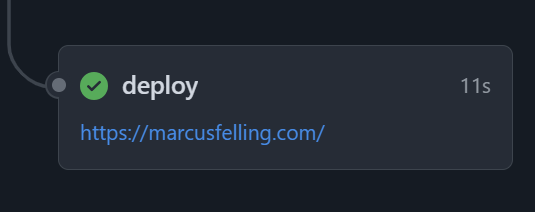⏩ Optimizing GitHub Actions Workflows for Speed and Efficiency

Slow CI/CD pipelines directly impact developer productivity and deployment frequency. When pull request checks take 15+ minutes to complete, developers context-switch to other tasks, breaking their flow and reducing productivity. Additionally, GitHub Actions charges by the minute, so inefficient workflows literally cost you money.
I’ll go through some optimization techniques I’ve found to be effective:
- Caching Dependencies
- Optimize Docker Usage
- Strategic Job Splitting and Parallelization
- Matrix Builds for Testing Efficiently
- Selective Testing with Path Filtering
- Self-hosted Runners for Specialized Workloads
- Monitoring Your Workflow Performance
- Conclusion
Caching Dependencies
The most immediate win for most workflows is proper dependency caching:
jobs:
build:
runs-on: ubuntu-latest
steps:
- uses: actions/checkout@v3
- name: Set up Node.js
uses: actions/setup-node@v3
with:
node-version: '16'
- name: Cache dependencies
uses: actions/cache@v3
with:
path: |
~/.npm
node_modules
key: $-node-$
restore-keys: |
$-node-
- name: Install dependencies
run: npm ci --prefer-offline --no-audit
The above example includes several optimizations:
- Caching both
~/.npmandnode_modules - Using lockfile hashing for cache keys
- Fallback cache keys for partial hits
--prefer-offlineflag to prioritize cached packages
Optimize Docker Usage
For workflows using Docker, image layering and caching are critical:
jobs:
docker-build:
runs-on: ubuntu-latest
steps:
- uses: actions/checkout@v3
- name: Set up Docker Buildx
uses: docker/setup-buildx-action@v2
- name: Cache Docker layers
uses: actions/cache@v3
with:
path: /tmp/.buildx-cache
key: $-buildx-$
restore-keys: |
$-buildx-
- name: Build and push
uses: docker/build-push-action@v4
with:
context: .
push: false
cache-from: type=local,src=/tmp/.buildx-cache
cache-to: type=local,dest=/tmp/.buildx-cache-new,mode=max
After your build, add this step to prevent cache size explosion:
- name: Move cache
run: |
rm -rf /tmp/.buildx-cache
mv /tmp/.buildx-cache-new /tmp/.buildx-cache
Strategic Job Splitting and Parallelization
Instead of sequential steps, split work into parallel jobs when possible:
jobs:
lint:
runs-on: ubuntu-latest
steps:
- uses: actions/checkout@v3
- uses: actions/setup-node@v3
# ...lint setup and execution
test:
runs-on: ubuntu-latest
steps:
- uses: actions/checkout@v3
- uses: actions/setup-node@v3
# ...test setup and execution
build:
runs-on: ubuntu-latest
needs: [lint, test]
# This job only runs after lint and test complete successfully
Matrix Builds for Testing Efficiently
For multi-environment testing, use matrix builds:
jobs:
test:
runs-on: ubuntu-latest
strategy:
matrix:
node-version: [14, 16, 18]
steps:
- uses: actions/checkout@v3
- name: Use Node.js $
uses: actions/setup-node@v3
with:
node-version: $
- run: npm ci
- run: npm test
Selective Testing with Path Filtering
Avoid running unnecessary jobs by filtering based on changed paths:
jobs:
frontend-tests:
if: |
github.event_name == 'pull_request' &&
(github.event.pull_request.base.ref == 'main' ||
contains(github.event.pull_request.labels.*.name, 'run-all-tests'))
runs-on: ubuntu-latest
steps:
- uses: actions/checkout@v3
- uses: dorny/paths-filter@v2
id: filter
with:
filters: |
frontend:
- 'frontend/**'
- 'shared/**'
- name: Frontend Tests
if: steps.filter.outputs.frontend == 'true'
run: npm test
Self-hosted Runners for Specialized Workloads
For specific needs like GPU access or large compute requirements, self-hosted runners can dramatically improve performance:
jobs:
gpu-training:
runs-on: self-hosted-gpu
steps:
- uses: actions/checkout@v3
# GPU-intensive tasks here
Monitoring Your Workflow Performance
GitHub provides insights into workflow run times. Use the GitHub API to track this data over time:
async function getWorkflowRunTimes(owner, repo, workflow_id) {
const { Octokit } = require("@octokit/rest");
const octokit = new Octokit({ auth: process.env.GITHUB_TOKEN });
const runs = await octokit.actions.listWorkflowRuns({
owner,
repo,
workflow_id,
});
return runs.data.workflow_runs.map(run => ({
id: run.id,
duration: new Date(run.updated_at) - new Date(run.created_at),
conclusion: run.conclusion
}));
}
Conclusion
Optimizing GitHub Actions workflows is an ongoing process. Start with the high-impact items like caching and job parallelization, then iteratively improve based on metrics. The reward is not just faster builds but happier developers and lower costs.